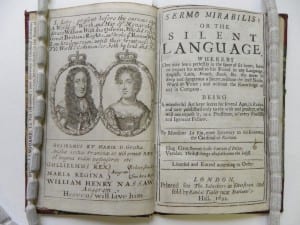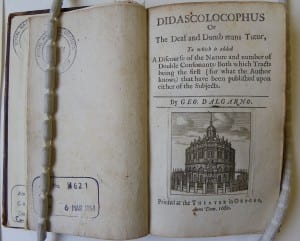Sign alphabet exhibition – Sermo Mirabilis
By H Dominic W Stiles, on 3 July 2013
Sermo mirabilis, or, The silent language whereby one may learn in the space of six hours, how to impart his mind to his Friend in any Language, English, Latin, French, Dutch, &c. tho never so deep and dangerous a Secret, without the least Noise, Word or Voice; and without the Knowledge of any in the company. Being an art kept secret for several ages in Padua, and now made published only to the wise and prudent, who will not expose it, as a Prostitute, to every Foolish and Ignorant Fellow. by Monsieur La Fin, once secretary to His Eminence, Cardinal Richlieu. London, Tho. Salusbury, 1692. Charles La Fin 1692
Charles de la Fin or La Fin(?fl.1640s-1690s?) used different parts of the body to indicate letters, so ‘L’ was represented by the Lip, ‘W’ by the wrist etc. The vowels were the same as in modern British fingerspelling, indicated by the thumb and fingers. La Fin describes in his book how he taught a young gentleman the art, who was then able to use it to woo a lady in the presence of her family.
La Fin was, according to the book’s title page, sometime secretary to Cardinal Richelieu (d.1642), and according to a book called More good and true news from Ireland where a letter of 1641 from him to his brother James appears, he was “page to the young Prince of Orange” who was later to become William II, Prince of Orange, father of William III King of England. His brother James was secretary to the exiled French Duke of Valette. I cannot be certain but it seems that this Charles is the same person as the author of Sermo mirabilis, although this book was written some fifty years later.
The dedication to William and Mary shows La Fin to have been a firm supporter of the House of Orange.
I have photographed the whole thing available as a pdf here Sermo mirabilis – see if you find this system usable!
 Close
Close




